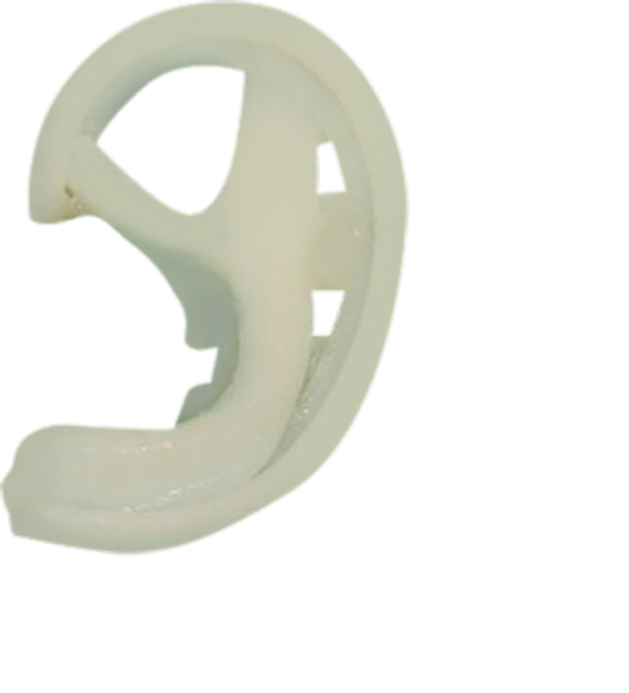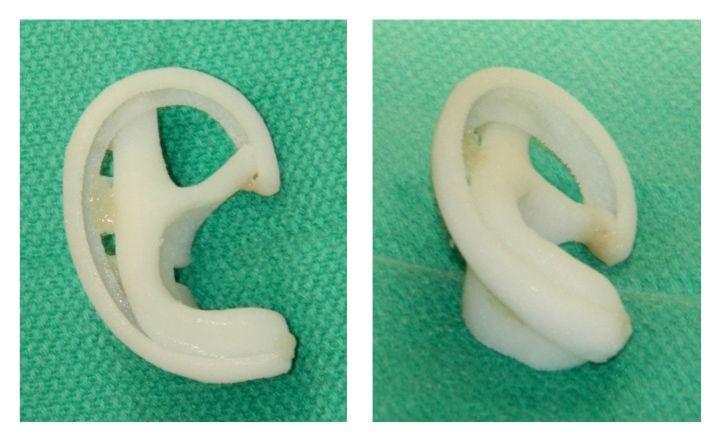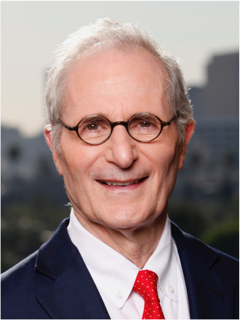
MEDPOR Ear Reconstruction

MEDPOR: A State-of-the-Art Treatment
That Produces Highly Aesthetic Results
MEDPOR provides numerous advantages over the traditional procedure, leading many experts to believe it is the best surgical treatment for microtia. These benefits include:
An Expedited Treatment Timeline
MEDPOR ear reconstruction is a single-stage surgery, which is especially beneficial for our out-of-town or international patients. The surgery can be completed in a few hours, and our team will contact you every 90 minutes throughout the procedure to keep you updated on the progress.
Improved Hearing Capabilities
Dr. Reinisch in Beverly Hills may perform ear canal repair before or during MEDPOR surgery. When he addresses aural atresia at an early age, children can experience better hearing and an improved ability to process and learn language.
A Better Quality of Life
This treatment can help your child face a lower risk of developing speech disorders and language difficulties. Moreover, when the doctor corrects the cosmetic aspects of microtia before children start school, they can avoid a significant amount of psychological distress.
What do MEDPOR implants look like?

Is this technique safe and reliable?
Hundreds of Thousands of Surgeries Have Been Performed Using MEDPOR
More Information
About MEDPOR Ear Reconstruction
Although there has been a well-established surgical microtia treatment for over 55 years, Dr. John Reinisch saw a need to create a more advanced technique that could provide improved cosmetic results. He also wanted to treat children with less discomfort and at an earlier age. In 1991, he introduced an innovative new technique called MEDPOR® ear reconstruction. Patients travel from around the world to our Beverly Hills microtia surgeon's office to receive this advanced treatment. During MEDPOR® surgery, Dr. Reinisch creates a polyethylene framework and grafts a patient’s own skin over the structure. The safe, effective technique offers a number of benefits. It is suitable for patients ages three and above. It has also been successful for patients in their 50’s and 60’s.
The MEDPOR Technique
MEDPOR stands for microporous high-density polyethylene implant. This implant is 100 percent biocompatible. Before attaching an implant, Dr. Reinisch will create the MEDPOR ear framework. He will carefully refine it to match the shape and projection of the opposite, natural ear. In this way, he can eliminate the need for a future ear pinning surgery.
Dr. Reinisch will perform MEDPOR surgery under general anesthesia. For optimal patient safety, he works with several pediatric anesthesiologists. Once the implant is in place, he will graft skin over the structure. Typically, he will take this tissue from beneath the patient's scalp, resulting in virtually undetectable scarring. The MEDPOR framework is porous. Therefore, surrounding blood vessels and skin can integrate with the material.
Candidates for the MEDPOR Technique
One of Dr. Reinisch’s primary goals in the creation of the MEDPOR technique was to be able to treat microtia in younger patients. This method is suitable for patients as young as three or four. However, because it requires general anesthesia, children should weigh at least 28 pounds before undergoing surgery. Additionally, patients should be in good health. If your child has a compromised immune system due to a chronic disease, surgery may not be advisable. Dr. Reinisch in Beverly Hills may reschedule surgery if your little one has a short-term illness, such as a cold or infection.
If your child suffers from aural atresia as well as microtia, there are additional factors to consider. Dr. Reinisch will consider the internal structure of your child’s ear. He will work with an audiologist to determine the likelihood of a successful ear canal reconstruction. If ear canal reconstruction is not possible, your child may still qualify for a polyethylene implant for cosmetic reasons.

The MEDPOR technique can help children as young as three achieve a normal appearance.
The MEDPOR technique also offers functional benefits over other methods of ear reconstruction. Because the structure will bond with a patient’s own tissue, it is very sturdy. The polyethylene implant can still become damaged, but the risks are the basically the same as injury to a natural ear. As a result, children will be able to participate in the same sports and activities as their friends. The ear will also function almost identically to biological ears. Though it will be slightly less sensitive than cartilage, your child will still have a sense of touch in this area.
Aftercare & Healing
Following surgery, Dr. Reinisch will place a protective silicone cover over the new ear to aid in healing and encourage proper contouring. Patients will have at least two follow-up appointments. The first takes place one to two days after surgery and the second is about two weeks later. Many patients stay several weeks to benefit from ongoing supervision and care. We proudly partner with the local Ronald McDonald House, which provides accommodations to families traveling for medical treatment.
MEDPOR surgery typically results in less scarring than traditional surgical techniques. When Dr. Reinisch creates the ear framework, it will be constructed to be the same size as an adult ear. Although it may look slightly large for several years, young patients can experience a natural appearance, increased self-confidence, and enhanced hearing for the rest of their lives.
The Cost of MEDPOR
The MEDPOR technique requires a single outpatient procedure. Therefore, it will typically cost less than rib cartilage reconstruction, which requires a series of surgeries. Our team strives to make all of our treatments affordable. Our office staff will work with your insurance provider to obtain the greatest amount of coverage possible. If you do not have insurance or you need help with out-of-pocket expenses, we accept CareCredit® patient financing. There are several repayment options available, and we can help you find an affordable, low-interest plan. In select cases, we may be able to assist you through the Small Wonders Foundation. Dr. Reinisch established this non-profit specifically to help the families of children with birth defects.
How Does MEDPOR Compare to Rib Cartilage Ear Reconstruction?
The key difference between MEDPOR and rib cartilage ear reconstructions is the material used to rebuild the ear. Where MEDPOR uses a microporous high-density polyethylene implant, rib cartilage ear reconstruction uses the patient’s natural tissue as the framework. This procedure requires an initial surgery to collect cartilage from the rib cage. There are a variety of other aspects of each procedure which patients and parents must consider.
Minimum Age Requirements
With MEDPOR ear reconstruction, Dr. Reinisch can treat microtia in patients as young as three or four years old. For a rib ear reconstruction, we have to wait until about age eight to 10, well after children have already started school, for the child to have sufficient rib cartilage to create the framework.
Number of Surgeries
At our practice, MEDPOR ear reconstruction is a single-stage surgery, saving patients and their families time, money, and discomfort. A rib cartilage ear reconstruction typically requires two to five surgeries to complete. The cartilage will need to be harvested, formed into a framework, and placed in a separate procedure. In some cases, patients will need additional procedures to elevate the ear, reposition the earlobe, or perform other adjustments.
Scarring and Discomfort
Dr. Reinisch in Beverly Hills created the MEDPOR technique as a way to treat microtia with less discomfort than traditional methods. A rib cartilage reconstruction may be more painful for patients and is often associated with discomfort at the site where cartilage is harvested. There will also be a scar at the donor site. MEDPOR reconstruction typically involves less pain, and although Dr. Reinisch will need to collect a skin graft from beneath the scalp to cover the framework, he works carefully so there is essentially no visible scarring.
Why Choose Dr. Reinisch?
Dr. Reinisch invented the MEDPOR technique, making him uniquely qualified to perform your child’s surgery. Since its development over 20 years ago, he has modified and improved the procedure so it yields better results than ever before. Dr. Reinisch is an internationally recognized expert in ear reconstruction. He is also equipped to perform revision surgery whenever necessary.
Above all, Dr. Reinisch is committed to the safety and well being of his patients. He will answer all of your questions and help you to feel comfortable and confident about your surgery After performing the MEDPOR technique, he will provide thorough follow-ups to ensure your child’s health and long-lasting results.
Frequently Asked Questions
Is MEDPOR safer than rib cartilage reconstruction?
It is inappropriate to label one treatment safer than another, but MEDPOR is less invasive than rib cartilage reconstruction and requires fewer surgeries. As a less invasive procedure, MEDPOR has an inherently lower risk of complications.
Rib cartilage reconstruction is incredibly safe, but it has a longer timeline than MEDPOR, and is a multi-step process. It also carries some risk of chest wall deformity at the sites of harvested cartilage as the patient continues to grow. MEDPOR, on the other hand requires only one surgery and does not require us to harvest natural cartilage. Fully understanding the differences between these two procedures can help you make an informed decision.
Will a MEDPOR implant look natural as my child grows?
The MEDPOR implant is designed to be very lifelike, so it moves and feels very much like natural ear cartilage. It will not, however, grow with your child. To make sure the implant is an appropriate size for most of your child’s life, we base the size of the implant on the projected size of the other ear at its full state of development. To determine this size, Dr. Reinisch can take into account anatomical growth chart projections, the current size of the other ear, and the size of the biological parents’ ears.
To make sure the implant is an appropriate size for most of your child’s life, we base the size of the implant on the projected size of the other ear at its full state of development.
In most cases, these measurements are accurate, and there is no noticeable discrepancy between the size of the two ears. Most people do not realize that children’s ears reach their full adult size by about six years of age, so any minor size difference between the implant and natural ear will not last long. We have many patients who are satisfied with their final appearance after using MEDPOR implants.
Can the body reject a MEDPOR implant?
When the body rejects implanted human tissues, such as a heart or kidney, it does so in response to the living cells present in that organ. Since polyethylene implants are not alive, they are no more likely to be rejected than any other synthetic implants.
Unlike other implants, however, the MEDPOR polyethylene implant was designed to be porous, rather than walled-off from living tissues. This means the soft tissues surrounding the implant will grow into its surface over time, effectively fusing the implant with the surrounding living tissue. This ensures a more natural-feeling, natural-looking reconstruction.
Are MEDPOR implants susceptible to injuries?
Just like a natural ear, all reconstructed ears are susceptible to injury by direct trauma. That said, the materials used in MEDPOR are as flexible as natural tissues and have shown no greater propensity to be damaged by trauma than human cartilage. Traumatic injuries that damage polyethylene implants are very rare. It is more common for patients to bruise or cut the tissues that cover the implant, but these injuries usually heal naturally on their own in much the same way a natural ear would. In the event that a MEDPOR implant does fracture, we can replace it during a simple surgical procedure.
Our Multilingual Staff
To serve our many international patients, our staff is fluent in English, Spanish, Mandarin, Hungarian, Italian, and Russian.


